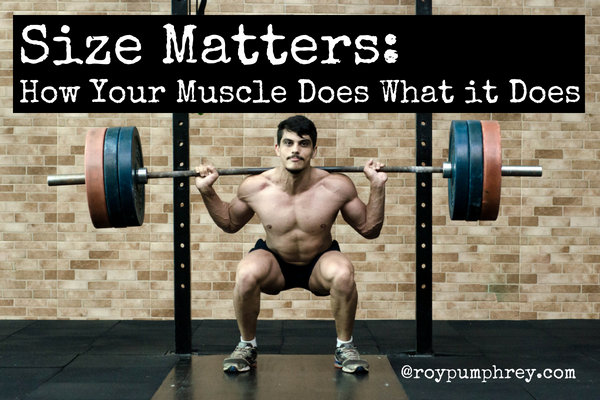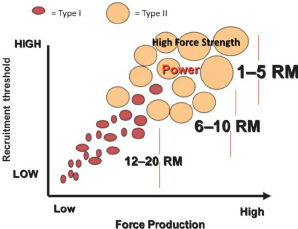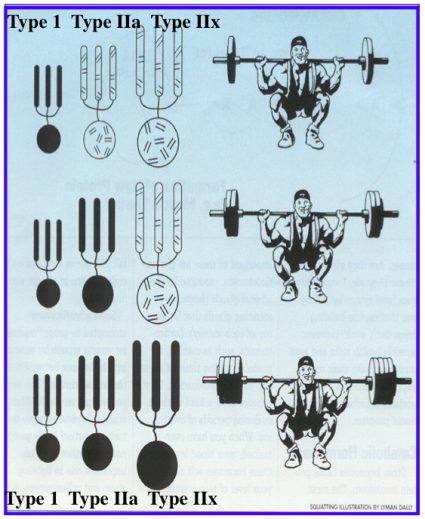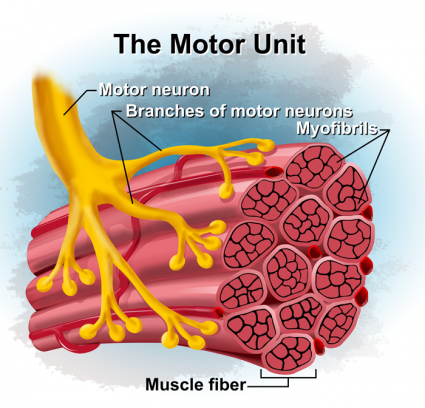
“That’s What She Said” – Michael Scott
What a way to start a science article, with dick jokes…
Am I right?
What the hell are we talking about?
The Henneman Size Principle
“The Size Principle of motoneuron recruitment stated that for any net excitatory input to the motoneuron pool, motoneurons were recruited in an orderly fashion, always from small to large.” – Assessment of Size Ordered Recruitment
Say Whaaaa?
A quad isn’t just a muscle.
Well it is.
But really a quad is a collection of motor units.
Motor Unit:
“A motor unit is a motor neuron and the muscle fibers it innervates. It consists of both a neuron (nerve cell responsible for stimulating a muscle cell) and the muscle cells themselves. Each type of motor unit possesses different characteristics.” –Athletic Lab
And a Motor Unit is (basically) either fast or slow twitch.
Fast Twitch Motor Unit/ Muscle Fibers:
Larger muscle fibers (groupings) that produce LOTS of force. <—the grouping of fibers is the motor unit. But in a motor unit all the fibers are the same..so they’re kinda interchangeable for our purposes.
While these are termed as “Fast Twitch” they do “come on line” only after the Slow Twitch muscles are deemed to produce insufficient force for the movement at hand. <—Size Principle, small to large.
The “threshold” of muscle activation is higher…hence the technical term, “High Threshold Motor Unit”.
These also fatigue rather quickly.
Slow Twitch:
Smaller muscle fibers/ motor units (groupings) that do not produce much force but are (probably) activated first.
These fatigue more slowly and are the predominant fiber type found in postural muscles.

RM = Repitition Maximum, From ResearchGate
Fiber Type Distribution:
Muscles tend to be a mixture of both fast and slow twitch.
Generally people are closer to 50/50, but that percentage can vary wildly, depending on the person and the muscle itself.
“Muscle fiber types differ between individuals, but they also differ between muscles. Some muscle groups are very slow twitch (they have a high type I muscle fiber proportion) and other muscle groups are very fast twitch (they have a high type II muscle fiber proportion). Most muscle groups display an even mixture of both fiber types, but the lower body is generally more slow twitch than the upper body.” – Strengthandconditioningresearch
It’s thought by some that training in a specific manner may cause fibers to transition but there really isn’t a ton of evidence and it might be self-selection in the athletes.
“Strength and power athletes tend to display a larger proportion of type IIA muscle fibers than untrained controls, while endurance athletes tend to display a larger proportion of type I muscle fibers.
Although training may play a role in causing fiber type shifts, there is likely a large genetic component in the determination of fiber type (possibly including the ACTN3 R allele). This may produce selection bias when performing cross-sectional studies of athlete groups.” –Strength and conditioning research
Yes, there are most definitely hybrid fibers that show a transition due to training, but these are far fewer in number when compared to just the gross number of Type I or II fibers you have.
Fun Fact(s):
#1: There are motor units (a neuron and all of the muscles cells it innervates) for the muscles around the eye that are a single muscle cell in size.
#2: There may be some cases, extreme high-speed/ force output events the size principle may…MAY be bypassed and the high and low threshold motor units are activated simultaneously.
This most likely ONLY occurs in genetic freaks of nature, like high level sprinters, jumpers, Olympic lifters and the like. Where, not only genetic freakery, but also high intensity training practiced for high volumes over years creates a “neurological bypass” of sorts.
Keep in Mind:
“A muscle will only recruit the minimal number of motor units required to perform a task.”- ShrededbybScience
 stolen from the U of New Mexico and the Iconic Len Kravitz
stolen from the U of New Mexico and the Iconic Len Kravitz
As I pick up a weight I need to accumulate force to lift that weight.
The Accumulation of Force Takes Time.
It takes time to activate more motor units in that muscle, and the other muscles that are needed to create the movement.
We all know this….
Which is Faster?
A: 65lbs deadlift
B: 400lbs deadlift
Obviously, the 65lbs deadlift is faster.
Why?
Because you can go up the light tree, activate the low threshold motor units and few(er) number of high threshold motor units faster than if you needed to summate (accumulate enough motor units) to lift 400lbs.
Summation of Force:
“The combination of forces produced by different parts of the human body. When a person is moving or attempting to move an object, several different parts of the body act together to maximize the force. In theory, force summation occurs when all body parts act simultaneously In practice, the strongest and lowest body parts around the center of gravity (e.g. trunk and thighs) move first, followed by the weaker, lighter, and faster extremities. This is known as sequential acceleration and results in successive force summation. To obtain a maximum force, summation also needs sequential stabilization of body parts, with some body parts having to be fixed at stable points while other parts produce the effective forces.” –Oxford Reference
But that Talks About Multiple Body Parts?
Well, yeah, because the body is made up of multiple parts and they all have motor units/ muscle fibers and contribute to movement.
Lets face it: ya can’t squat with just quads..it aint gonna happen.
So obviously, you need to create force in all of the muscles needed for the movement to occur.
Lets remember, even an isometric contraction is a muscle contraction.
From the above:
“To obtain a maximum force, summation also needs sequential stabilization of body parts, with some body parts having to be fixed at stable points while other parts produce the effective forces.”
Yeah, that’s saying you need some isometrics, a “fixed and stable” joint (non changing muscle length) to produce maximal muscle force in a movement.
Primary Movers
Are the muscles that are DRIVING the motion.
Again, the Conventional Deadlift:
Why not the sumo deadlift?
Cause sumo gives you cancer. <—-that’s a joke. Not really about cancer, but sumo deadlifting.
Primary Movers:
- Glutes
- Hamstrings
- Quads
Look at the joints these muscles attach to and cross.
The knee and hip.
That’s what moving in the deadlift. <—-if you include the low back, you’re lifting on borrowed time and should read this.
Primary (high force output) Stabilizers:
- Spinal Errectors
- Lats
- Forearms
- Upper Back
- Calves
If you’ve ever deadlifted (correctly) you know I’m right.
These muscles are SMOKED the next day.
Sometimes as much and maybe MORE than the primary movers.
While they didn’t actually provide movement they still had to contract forcefully to allow the Primary Movers to perform the movement at hand.
But I thought “Stabilizers” Were Teeny Tiny Muscles?
Typically what’s thought of as stabilizers are the smaller muscles.
Muscles like the ones that make up the rotator cuff and deep hip rotators however, as in the deadlift example, large muscles act as stabilizers frequently.
“Most often a muscle acts as a stabilizer in order to allow a different muscle to function as needed in the exercise. For example, the hip joint muscles may contract to stabilize the pelvis so that you can do an effective abdominal exercise. In this case the muscles acting as stabilizers hold the pelvis in place so that the abdominal muscles, when they contract, would raise the torso and not simultaneously raise the pelvis. Understand that when a muscle contracts it pulls equally from both ends. In order to have movement at only one end of the muscle other muscles must come into play to stabilize the bone to which the other end of the muscle is attached, in place.”– Dr. Yessis
See, when you’re trying to lift something reasonably heavy you need to summate a LOT of force.
Those itty-bitty, teeny-weeny muscles of the rotator cuff or hip ain’t gonna do it.
Wait, But What?
Stabilizers Don’t Stabilize?
The muscles that are commonly thought of as “Stabilizers” primarily function is NOT to “provide stability” (although that’s the product of those muscles functioning optimally) to the joint but to time and coordinate the centration of the joint allowing the primary movers to exert force optimally.
“the key characteristics associated with stabilizer muscles are muscle co-contraction, feed-forward/feedback control, and muscle recruitment patterns…..
stabilizer muscles can be defined as those that contribute to joint stiffness by co-contraction and show an early onset in response to perturbation via either a feed-forward or feedback control mechanism.” – Physiotherapy Canada
In normal person speak,
“postural stabilizer muscles work at the reflex level. They are anticipatory muscles, which means these muscles should be on and working before any movement actually occurs. In fact, they should be on before we even think about movement. This is different from our prime movers – those we have to think about.” –Cassie Dione
What’s commonly thought of as the stabilizers act BEFORE movement occurs to “SET” the joint allowing the PRIMARY MOVERS (large muscles) to produce (summate) force and direct that force in the way that’s optimal for that movement.
“Most of the stability that makes you do what you do, aligns your joints, creates dynamic posture and the perfect axis of rotation so your prime movers can fire occurs at about 20% of the maximal voluntary contraction.” – Gray Cook
Size Principle, Fast Twitch/ Slow Twitch and Stabilizers in Real Life
or
Why You Don’t Want to Rely Only on Your Rotator Cuff to Stabilize Your Bench Press.
(Gently) Toss me a baseball.
Not very heavy, not moving very fast, very easy to catch.
Low Force= Low Threshold Stimulus= Low Threshold Motor Units (slow twitch motor units) Activate to absorb the ball.
There’s not much need, if any at all, for the larger primary movers (lats, pecs) to contribute much to catching the ball. The smaller muscles of the rotator cuff and maybe some delt and/ or biceps can easily handle the load.
The “stabilizers” can easily centrate the joint and absorb the load.
Toss me a 10lbs plate
Medium Force= Medium Threshold Stimulus=Low and some High Threshold Motor Units must activate to absorb the force of the plate.
Not terribly heavy but enough that I’m going to need to more than just the small muscles of the rotator cuff.
Some primary movers containing high(er) numbers of high threshold motor units (fast twitch fibers) like the delts, biceps and triceps will have to contribute to catching the weight now, but I probably don’t need to rely on the core, quads, pecs etc any more than if I was just standing passively.
Toss me a 45lbs Plate:
High Force= High Threshold Stimulus= High Threshold Motor Units in Largest Primary Movers
Its going to take every muscle in the body to catch a 45lbs plate.
Not only is the rotator cuff going to be completely inadequate to handle absorbing this load, I’m going to need all of the smaller and larger primary movers and the fast twitch/ high threshold motor units in them to activate to absorb this load.
We’re talking, Delts, Biceps, Triceps, Pecs, Lats, Glutes, Quad, Hamstrings all coordinating together to brace, stabilize and absorb the force of catching a 45lbs plate.
The postural muscles at this point should only be worried about timing things up to center the joint allowing the primary movers can act (absorb/ create force) optimally.
Think About it:
Would you really want to be on the receiving end of a 45lbs plate and ONLY relying on your low threshold, slow twitch, postural muscles to catch it?
Bench 315lbs and only rely on muscles the size of your pinky to stabilize your shoulders joint?
Of course not.




[…] But primarily, motor control is reflexive. […]